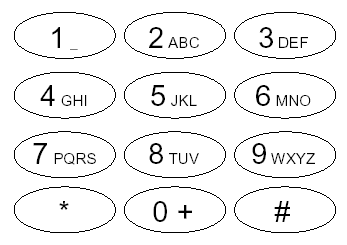A while ago it was quite cumbersome to create a message for the Short Message Service (SMS) on a mobile phone. This was because you only have nine keys and the alphabet has more than nine letters, so most characters could only be
entered by pressing one key several times. For example, if you wanted to type "hello" you had to press key 4 twice, key 3 twice, key 5 three times, again key 5 three times, and finally key 6 three times. This procedure is very tedious and keeps many people
from using the Short Message Service.
This led manufacturers of mobile phones to try and find an easier way to enter text on a mobile phone. The solution they developed is called T9 text input. The "9" in the name means that you can enter almost arbitrary words with just nine keys and without pressing
them more than once per character. The idea of the solution is that you simply start typing the keys without repetition, and the software uses a built-in dictionary to look for the "most probable" word matching the input. For example, to enter "hello" you
simply press keys 4, 3, 5, 5, and 6 once. Of course, this could also be the input for the word "gdjjm", but since this is no sensible English word, it can safely be ignored. By ruling out all other "improbable" solutions and only taking proper English words
into account, this method can speed up writing of short messages considerably. Of course, if the word is not in the dictionary (like a name) then it has to be typed in manually using key repetition again.

Figure 8: The Number-keys of a mobile phone.
More precisely, with every character typed, the phone will show the most probable combination of characters it has found up to that point. Let us assume that the phone knows about the words "idea" and "hello", with "idea" occurring more often. Pressing the
keys 4, 3, 5, 5, and 6, one after the other, the phone offers you "i", "id", then switches to "hel", "hell", and finally shows "hello".
Write an implementation of the T9 text input which offers the most probable character combination after every keystroke. The probability of a character combination is defined to be the sum of the probabilities of all words in the dictionary that begin with
this character combination. For example, if the dictionary contains three words "hell", "hello", and "hellfire", the probability of the character combination "hell" is the sum of the probabilities of these words. If some combinations have the same probability,
your program is to select the first one in alphabetic order. The user should also be able to type the beginning of words. For example, if the word "hello" is in the dictionary, the user can also enter the word "he" by pressing the keys 4 and 3 even if this
word is not listed in the dictionary.
The first line contains the number of scenarios.
Each scenario begins with a line containing the number w of distinct words in the dictionary (0<=w<=1000). These words are given in the next w lines. (They are not guaranteed in ascending alphabetic order, although it‘s a dictionary.) Every line starts with
the word which is a sequence of lowercase letters from the alphabet without whitespace, followed by a space and an integer p, 1<=p<=100, representing the probability of that word. No word will contain more than 100 letters.
Following the dictionary, there is a line containing a single integer m. Next follow m lines, each consisting of a sequence of at most 100 decimal digits 2-9, followed by a single 1 meaning "next word".
The output for each scenario begins with a line containing "Scenario #i:", where i is the number of the scenario starting at 1.
For every number sequence s of the scenario, print one line for every keystroke stored in s, except for the 1 at the end. In this line, print the most probable word prefix defined by the probabilities in the dictionary and the T9 selection rules explained above.
Whenever none of the words in the dictionary match the given number sequence, print "MANUALLY" instead of a prefix.
Terminate the output for every number sequence with a blank line, and print an additional blank line at the end of every scenario.
2
5
hell 3
hello 4
idea 8
next 8
super 3
2
435561
43321
7
another 5
contest 6
follow 3
give 13
integer 6
new 14
program 4
5
77647261
6391
4681
26684371
77771
Scenario #1:
i
id
hel
hell
hello
i
id
ide
idea
Scenario #2:
p
pr
pro
prog
progr
progra
program
n
ne
new
g
in
int
c
co
con
cont
anoth
anothe
another
p
pr
MANUALLY
MANUALLY
题意:首先给定n组字符串s和数字a,表示该字符串s输入过a次,接下来q次输入,每次输入表示按键顺序(使用手机输入发那种),问每次按键可能出现的字符串,按使用频率高的输出,若没有则输出MANUALLY
注意:每个数字代表一个字母,如果要找出两个长度的答案,那么在两个长度的所有可能中找出出现频率最高的。
#include<stdio.h>
#include<string.h>
//#include<malloc.h>
typedef struct nn
{
int prio;
struct nn *next[26];
}node;
typedef struct nnn
{
int maxprio;
char str[105];
}ansseme;
node *builde()
{
int i;
node *p=new node;//node *p=(node*)malloc(sizeof(node));
p->prio=0;
for(i=0;i<26;i++)
p->next[i]=NULL;
return p;
}
node *root;
void insert(char str[],int prio)
{
node *p=root;
int i;
for(i=0;str[i]!='\0';i++)
{
if(p->next[str[i]-'a']==NULL)
p->next[str[i]-'a']=builde();
p=p->next[str[i]-'a'];
p->prio+=prio;
}
}
int l;
char num[105];
ansseme prin[105];
char ch[10][5]={"abc","def","ghi","jkl","mno","pqrs","tuv","wxyz"};
void dfs(int i,node *p,char pre[])
{
int len=strlen(ch[num[i]-'2']),ti=0,cc[4],pri[4],j;
for( j=0;j<len;j++)
if(p->next[ch[num[i]-'2'][j]-'a']!=NULL)
{
pri[ti]=p->next[ch[num[i]-'2'][j]-'a']->prio;
cc[ti++]=ch[num[i]-'2'][j]-'a';
}
for( j=0;j<ti;j++)
{
pre[i]=cc[j]+'a'; pre[i+1]='\0';
if(prin[i].maxprio<pri[j])
{
prin[i].maxprio=pri[j]; strcpy(prin[i].str,pre);
}
if(l>i+1) dfs(i+1,p->next[cc[j]],pre);
}
}
int main()
{
int t,cas=0,n,prio,i;
char str[105];
scanf("%d",&t);
while(t--)
{
scanf("%d",&n);
printf("Scenario #%d:\n",++cas);
root=builde();
while(n--)
{
scanf("%s %d",str,&prio);
insert(str,prio);
}
scanf("%d",&n);
while(n--)
{
scanf("%s",num);
l=strlen(num)-1;
for( i=0;i<=l;i++)
prin[i].maxprio=0;
str[0]='\0';
if(l) dfs(0,root,str);
for( i=0;i<l;i++)
if(prin[i].maxprio)
printf("%s\n",prin[i].str);
else
printf("MANUALLY\n");
printf("\n");
}
printf("\n");
}
}
